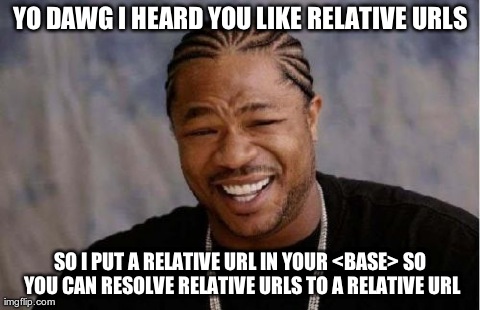MDN says FF has “implemented” the SVG text module, then goes on to list 13 presentation attributes which “don’t work”. How exactly does that count as implementing the module? Grr. This is why @supports is doomed.
Just in case anyone was wondering, the “HA HA HA SOUP” bookmark in those gifs is this bookmarklet:
document.createTreeWalker is actually pretty great.
git pull origin hamster
For the tenth time today.
Uh-oh, markdoesntunderstandanimals.com has gone offline. Time to crank up wget, pointed at markdua.tumblr.com #sitedeath
If you want to maintain a personal copy too, here’s the command:
wget -r http://markdua.tumblr.com -D 25.media.tumblr.com,markdua.tumblr.com -H -w 1
I need some musical help! What time signature is this clip in? It’s been rolling around in my head for the past three weeks but I can’t figure it out.
K:Amin
AB cd- dc _ed cd cB cd |fe de- ec2 AB cA _ed cd :|
The problem seems to be around the 19-20th notes — that’s how I play it but it means there’s an extra quaver. Otherwise it could almost be alternating bars of 7/4 and 8/4. Any ideas?
Loving Django’s prefetch/select_related — that, along with a few small changes, reduced a task which was taking > 500,000 queries to 4558
I’m thinking the time might have come to write a wrapper around #php DOMDocument which actually makes it usable. Thoughts:
- automatic conversion of various encodings to HTML entities to scoot round encoding issues
- XPath queries still work but
querySelectorandquerySelectorAllare implemented for both the document and individual elements via Symfony XPath → CSS converter and relative XPath queries - A DOMNodeList which actually implements ArrayAccess instead of acting like a fake array
- Perhaps some javascript-inspired property names like
innerText,innerHTMLfor consistency - Maybe some jQuery-influenced shortcut goodness for doing things like removing/replacing elements
@benwerd loving your work on idno! Just had a look at the source, great that you’re using #microformats 2, I have some suggestions/corrections:
.h-entryis better off where you’ve got.idno-entryso then the author.h-cardcan be scoped into the entry- add
.p-authorto the.h-cardfor each.h-entryto explicitly declare authorship - put
.h-as-*on the same element as.h-entry .idno-entry - put
.u-urlwhere you currently have.dt-published, move.dt-publishedto thetimeelement
Thanks to Aaron Parecki you can see how a page is parsed here, or use my php-mf2 demo sandbox for experimentation by hand.
Hey @appdotnet @daltoncaldwell, what happened to rel=me on personal homepage links on app.net? /cc Aaron Parecki Erin Richie #indieweb #indieauth
#django tip: if you come across weird inconsistencies between apps when trying to serve static files in dev, run with runserver --insecure even if you have DEBUG=True
git grep is pretty amazingly fast — get line numbers too with -n or git config --add grep.lineNumbers true
#TIL that you can put a relative URL in <base> (via Tantek Çelik)
Testing websites on old windows mobile devices is an… experience.
Connecting to WiFi gave me the option of connecting to “The Internet” or “Work” (?).
On form submit using the software keyboard, I get a dialog warning me about the certificate, with the options “yes” and “no” but no question. Turns out the software keyboard was hiding “Do you want to proceed?”
Now I’m finally in the site, there’s no support for label, so those nice big touch targets I made are mostly useless. Also, there’s no text wrapping.
Turns out the #microformats 2 JSON structures enable safe entity expansion just like twitter entities.
In my reply contexts I am not wanting to embed 3rd party HTML in my site, so I take the p-summary and strip tags. But, I want embedded h-cards to be expanded just like at-mentions on twitter. Pseudocode:
let h-card = canonical JSON structure for a note, with .summary as a plaintext representation of the content;
for item in h-card.children:
if not in_array('h-card', item.type) continue;
let html = HTML representation of the child from properties.url, name, etc;
replace item.value in h-card.summary with html
Example here.
Just hooked up my #indieweb notes to Brennan Novak’s rather awesome @emoome sentiment analysis API! So all my notes will have automated emotion/language analysis applied now, which I can query through machine tags.
At the moment I’m not publicly showing this data, but if you can read HTML it’s in the source (machine tags not shown by default) and if you can read JSON, add .json onto the end of the URL.
Julien Genestoux I’ll probably add one this afternoon — wrapped in a subscribe webaction, of course :)
Is the convention to have just one for the homepage (i.e. subscribe to “me”), or to have one wherever there is a feed (e.g. on my notes or articles pages?
Turns out that performing a GET request on a data URI from PHP works if file_get_contents is used, not if cURL is used. I wonder what support is like for other server side languages — using data URIs in with could be the basis of some interesting #webactions.
Laurent Eschenauer thanks for the heads-up, on closer inspection it looks like the problem is on your end — the URL in the with attribute of the action element has that quote at the end

 Laurent Eschenauer
Laurent Eschenauer